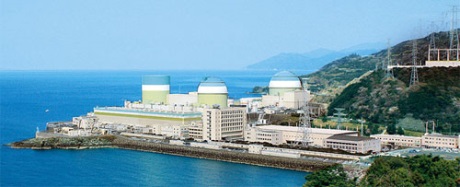Shikoku decides to retire Ikata 2
Unit 2 of the Ikata nuclear power plant in Japan's Ehime prefecture is to be decommissioned, Shikoku Electric Power Company announced today. It becomes the ninth operable Japanese reactor to be declared for decommissioning since the Fukushima Daiichi accident.

The three-unit Ikata plant (Image: Shikoku)
The utility said its board of directors made the decision at a meeting today not to restart Ikata 2. Shikoku said the cost and scale of modifications required to upgrade the 40-year-old unit to meet the country's revised safety standards made it uneconomical to restart the reactor.
Ikata 2 is a 538 MWe pressurised water reactor (PWR) that began operating in March 1988. It was taken offline in January 2012 for periodic inspections.
Shikoku president Hayato Saeki said he has informed the governor of Ehime prefecture and the mayor of Ikata city of the board's decision.
The company decided in March 2016 to decommission unit 1 of the Ikata plant, also a 538 MWe PWR, which began commercial operation in September 1977. That unit had been taken offline in September 2011 for periodic inspections. Upgrades costing more than JPY170 billion (USD1.6 billion) would have been needed at the unit in order for it to operate beyond 40 years.
Saeki said, "In the future, we will steadily proceed with various procedures following the closure of unit 2 and will strive for decommissioning in conjunction with unit 1, with the highest priority for ensuring safety."
Ikata 3 had been idle since being taken offline for a periodic inspection in April 2011. It was given approval by the Nuclear Regulatory Authority to resume operation in April 2016. Shikoku began the process to restart the 846 MWe PWR on 12 August and the unit was declared back in commercial operation on 7 September 2016. However, in December 2017, a Japanese high court ordered the suspension of the unit's operation. The injunction is effective until the end of September 2018.
"With regard to unit 3, which will be the remaining operating unit, we will continue to ensure safety," Saeki said.
In mid-March 2015, the Ministry of Economy, Trade and Industry's Agency for Natural Resources and Energy revised the accounting provisions in the Electricity Business Act, whereby electric power companies can now calculate decommissioning costs in instalments of up to ten years, instead of one-time as previously. This enhanced cost recovery provision was to encourage the decommissioning of older and smaller units.
The formulation of that system prompted the announcement that five of Japan's smaller operable nuclear power reactors would be decommissioned. These included Kansai Electric Power Company's Mihama units 1 and 2; unit 1 of Japan Atomic Power Company's Tsuruga plant, as well as Kyushu Electric Power Company's Genkai 1 and Chugoku Electric Power Company's Shimane 1.
In December 2017, Kansai announced that it would not seek permission to restart units 1 and 2 of its Ohi nuclear power plant in Japan's Fukui Prefecture. The two 1175 MWe pressurised water reactors became the first reactors with capacities over 1000 MWe to be decommissioned following the accident at the Fukushima Daiichi plant in March 2011.
Last December, the government also formally announced its decision to decommission the idled Monju prototype fast breeder reactor.
- China Institute of Atomic Energy
- Nuclear Power Institute of China
- Southwestern Institute of Physics
- China Nuclear Power Operation Technology Corporation, Ltd.
- China Nuclear Power Engineering Co., Ltd.
- China Institute for Radiation Protection
- Beijing Research Institute of Uranium Geology (BRIUG)
- China Institute of Nuclear Industry Strategy (CINIS)
- China Nuclear Mining Science and Technology Corporation


